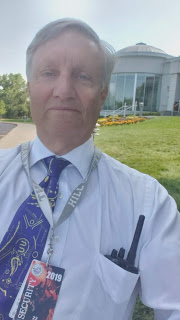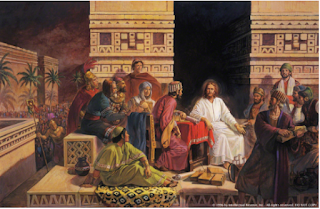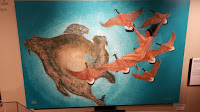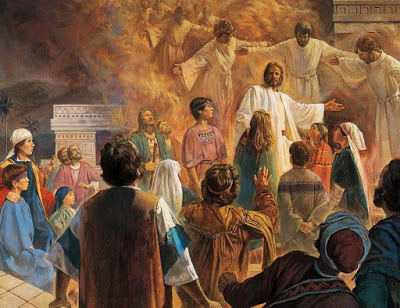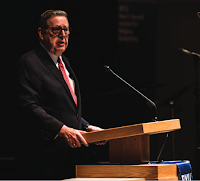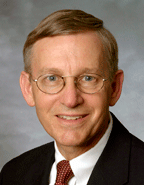(Note: I don’t accept the theory that Joseph didn’t really translate the plates, but instead simply read words that appeared on a stone in a hat, but that’s a topic for another post.)
Don’t confuse terminology with underlying meaning. For example, what human civilization has not had some form of “secret combinations” (Ether 8)? Are they absent in today’s America? 10th century China? Colonial Africa? Of course not. What human has no secrets? What society has no groups of people who combine to accomplish objectives? It would be far more surprising if these things were absent in the early 1800s than that they existed in Joseph Smith’s environment.
EVANGELICALISM
DARTMOUTH COLLEGE
- Richard K. Behrens, “Dartmouth Arminianism And Its Imapct on Hyrum Smith and the Smith Family,” The John Whitmer Historical Association Journal, Vol 26 (2006): 166–84.
MANIFEST DESTINY / AMERICAN EXCEPTIONALISM
This background is all consistent with both theories: Joseph as translator, and Joseph as composer. If the narrative in the Book of Mormon relates an actual and accurate history, these same legends would have arisen because, as the text explains, the Lamanites destroyed every Nephite record they could get and didn’t keep records of their own.
ABUNDANT BOOKS
Obviously, the last sentence is argumentative mind-reading, not factual. In my view, for Joseph (or anyone) to translate an ancient record, he/she would have to be prepared by developing a mental language bank of terminology and concepts sufficient to convey the original material (the Nephite plates) into the target language (English). All the resources available to Joseph would serve as preparation whether he translated or composed the text.
In my upcoming book, I have examples of specific origins for most of the Book of Mormon and other early texts.
- A New and Complete Illustration of the Occult Sciences, Ebenezer Sibly, Book 4, p. 1084- 85)
JOSEPH’S STORYTELLING
Note the argumentative adjectives in that sentence: profound, fascinating.
Joseph said that, on the night of the first visit, “I was also informed concerning the aboriginal inhabitants of this country and shown who they were, and from whence they came; a brief sketch of their origin, progress, civilization, laws, governments, of their righteousness and iniquity, and the blessings of God being finally withdrawn from them as a people, was [also] made known unto me.“
He went on to explain that during the ensuing 4 years, “After having received many visits from the angels of God, unfolding the majesty and glory of the events that should transpire in the last days, on the morning of the 22nd of September, A.D. 1827, the angel of the Lord delivered the records into my hands.“
One can choose to disbelieve Joseph, but his explanation fits all the known facts, including Lucy’s statement.
VIEW OF THE HEBREWS
The logical fallacy here is the irrelevance of how many “Mormons today” have heard of View of the Hebrews. In Joseph’s day, the book was known well enough to have extractions from the book published in the Times and Seasons in Nauvoo. The actual evidences cited by Ethan Smith support the history in the Book of Mormon, even though Ethan Smith’s explanation differed.
It makes sense to me that Oliver and/or Joseph read View of the Hebrews. It seems unlikely that they would not have. But again, that’s evidence of both composition and translation.
VIEW OF THE HEBREWS SUMMARY
- Rejection of Jesus Christ as our atoning Savior.
- O Jerusalem! Thou that killest the prophets – destruction of Jerusalem. [p.19]
- A prophet ascends the walls, in tremendous voice exclaimed, ‘Wo, wo to this city, this temple, and this people!’, while arrows shot at him. [p.26]
- The natives of our country are the outcasts of Israel – they have lost their way…bewildered in darkness. [p, vii]
- Found themselves involved in darkness…that they would take the book which the white people call the word of God, to throw light on their path. [p, vii]
- American Indians derive their origin from a foreign stock. [p. 159]
- Tools of iron not being found in these works, is no sign they did not possess them. For had they been there, they would, no doubt, long since have been dissolved by rust. [p. 194]
- After they settled in America they became wholly separated from the hunting and savage tribes of their brethren…lost the knowledge of their having descended from the same family.
- The more civilized part continued for many centuries; tremendous wars were frequent between them and their savage brethren, till the former became extinct. [p. 173]
- This accounts for the ancient works…centuries before Columbus discovered America…and articles dug from old mounds in and near those fortified places. [p. 173]
- The savage tribes prevailed…annihilated their more civilized brethren. …This accounts for their loss of the knowledge of letters, of the art of navigation, and of the use of iron. [p. 172]
- People of Israel who came into the western continent maintained some degree of civilization for a long time…finally became extinct, at least in North America, under the rage of their more numerous savage brethren. [p. 188]
- Situated in the midst of savage tribes from their race…degenerated…intent on the destruction of this better part of their brethren…struggling to maintain their existence and to maintain their religious traditions, they would naturally form many of the very things above enumerated, walled towns, forts, temples, altars, habitations of chieftains, watch towers. [p. 189]
- An old Indian informed him that his fathers in this country had…a book which they had for a long time preserved. But having lost the knowledge of reading it, they concluded it would be of no further use to them; and they buried it with an Indian Chief. [p. 223]
- They would preserve these fragments of their better days with the utmost care. Wherever they went then, they would have these with them…keep them with diligence…most precious contents…fearing these precious leaves would get lost. [p. 224]
- It was buried; and hence was providentially transmitted to us. [p. 225]
- Some modern Jew left it there in the situation in which it was found…on Indian Hill underground. [p. 225]
- The account of the old Indian, that his fathers had buried, not long ago, a book which they could not read. [p. 227]
- The prophet Isaiah to be of deep interest to America. [p. 228]
- The great and generous Christian people, who occupy much of the land of those natives, and who are on the ground of their continent, and hence are the best prepared to ameliorate their condition, and bring them to the knowledge and order of the God of Israel, must of course be the people to whom this work is assigned. [p. 230]
- They will be fulfilled only in the conversion of these ancient people of God to Christianity. [p. 64]
- This address of heaven must be to our western continent; or to a hospitable people found here… the two great wings of North and South America meet. [p. 238]
- Go thou nation highly distinguished in the last days (America), save the remnant of my people. [p. 250]
This is an important point. Confronted with the physical evidence of the mounds, their contents, and the Indian customs that included what seemed to be Hebrew elements, as well as the relevant texts of the Bible, Ethan Smith came up with his explanation. The Book of Mormon gave a different explanation for that same evidence.
Of course, the Book of Mormon includes other details that were not known until well after the Book of Mormon was published, such as the earlier Jaredite (Adena) culture that largely disintegrated before the Nephite (Hopewell) culture.
The point is, given the evidence Ethan Smith relied on, his book was arguably as plausible as the Book of Mormon. Subsequent scientific discoveries, however, show that Ethan Smith’s explanation doesn’t work, but the historical narrative in the Book of Mormon does.
WHAT DID B.H. CONCLUDE?
This is a bizarre appeal to authority that simply repeats the logical fallacy of Roberts’ thinking, at least as that thinking is portrayed here. A “close encounter” with View of the Hebrews is consistent with both composition and translation.
THE LEGEND OF CAPTAIN KIDD
Connecting the Hill Cumorah with the island Comoros (or Comore) has the obvious implausibility of a hill vs island. Connecting a capital city with a person compounds the implausibility, but implausibility is in the eye of the beholder, so we should consider the possibility of a connection.
The point of this article is that these place names were so commonly known that Joseph almost certainly saw them. But that same alleged common knowledge of Captain Kidd, Comoros Islands, and Moroni argues against Joseph adopting the same names if he was pretending to write an ancient history. IOW, the similarity would be too obvious to his own family, let alone everyone who read the Book of Mormon or heard the missionaries speak about Cumorah. I’m not aware of any of Joseph’s critics making this connection until long after Joseph and his contemporaries had died off.
There are virtually infinite place names if one looks at enough maps, especially if one transliterates foreign names. There are other transliterated terms in the Book of Mormon. It’s possible that Joseph transliterated Cumorah and Moroni, using the closest English terms he knew.
There are other possibilities. I’ve visited the Comoros Islands and its capital Moroni. The origins of the real-world names Comoros and Moroni are unknown, although there are theories based on Arabic. If we postulate that these islands were inhabited around 600 BC, of which there is currently no evidence but it would be nearly impossible to find such evidence given the volcanic nature of the island, it could have had ancient names that survived through later Arabic conquest.
The Comoros islands are along Lehi’s probable route. That means the Nephites could have acquired the name when they stopped there and then applied that name to the hill in New York. Possibly the same thing happened with the name Moroni.
All of these possibilities are pure speculation, of course. There is just enough “evidence” to confirm whatever bias one has.
- Joseph Smith, Captain Kidd Lore and Treasure Seeking, Dialogue, Noel Carmack, 2013
- Joseph Smith, Captain Kidd, Cumorah, and Moroni, Grant Palmer, 2014
CULTURAL TIMELINE OF JOSEPH SMITH’S DAY
This is a good start to the cultural environment, but there are other elements that I consider even more significant. None of this is proof of composition, of course, because the identical elements would be essential for Joseph to translate the plates.
CONCLUSION
This conclusion is not unreasonable but it’s incomplete. I agree with the proposition that Joseph was neither ignorant nor culturally isolated, but his own statements and those of his contemporaries made that clear all along (even though they have been misinterpreted by some, both critics and apologists).
The conclusion is incomplete because it doesn’t acknowledge that these facts support both composition and translation; i.e., for Joseph to translate the ancient records, he needed the vocabulary, cultural context, and theological understanding to render the ancient writings into the target language of English in the culture of his day.
It is other evidence that tips the balance toward translation, a topic of another post in this series.
[1] Natural Born Seer, p. xii.
[2] The Millennial Harbinger, Vol. 2: 93.
[3] The Indians, The Evening and The Morning Star, Dec 1832.
[4] The New-York Canals, Wayne Sentinel, June 30, 1824: 2.
[5] Lucy Smith, Biographical Sketches, 85.
[6] Studies of the Book of Mormon, 250.
[7] B. H. Roberts, Studies of the Book of Mormon, 240.
[8] Studies of the Book of Mormon, 243, 271.
[9] Dan Vogel, Early Mormon Documents, 3:148.
